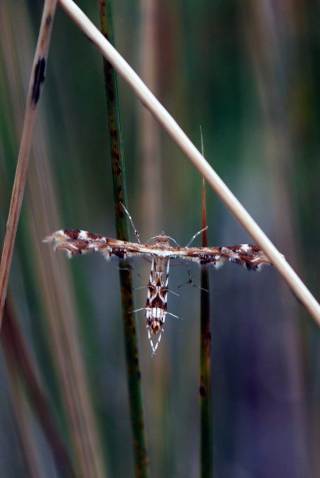Last week while I was out taking pictures of the muhly grass that’s just now beginning to flower (a sure sign of fall here in “seasonless” Florida), I ran across a flying beast that introduced me to a new lepidopteran family: the plume moths, Pterophoridae. These unusual little (and I mean little—these guys are tiny! The one I photographed has a wingspan of about 20mm [that’s 3/4 inch to you and me in daily life]) guys have very cryptic body shapes to help them hide in the grasses where they thrive. Part of that camouflage consists of little bristly projections sticking out here and there on their bodies that helps to break up their body outline. But the modification that gives the group its name (in both English and taxonomic-speak) are the wispy, feathery “plumes” on most species’ wings (that link takes you to the Moth Photographers’ Group page devoted to unidentified pterophorideans).
They also have a very characteristic T-shaped resting posture, as you can see in this photo I took last week (and almost all photos of pterophoridans):
I haven’t been able to get an ID on this species, but that’s not terribly surprising. According to plumemoth.com,
While the family Pterophoridae is easily identified, species determinations are more challenging, often requiring dissection and preparation of genitalia slides. There are currently 159 described species known from North America north of the Mexican border. Descriptions of at least 10 new species are anticipated along with some fluctuation in the total number of species from changes in synonymies.
Since I’m not really a dissection kind of guy, I’m content to have learned about a new component of my little patch of south Florida habitat.
Here’s a better shot of the bristles that cover this animal’s body:
There are probably some plume moths in your yard; why not take a look?



I just found one of these in my house! I’ve lived in SW FL (off and on) for 30 years, and this is the first time I’ve seen one. Interesting little guy. Now I just need to carefully catch it and move it outside.
They’re quite inconspicuous, aren’t they? I see them in my lawn all the time; haven’t had one wander inside yet, but I’m sure it’s only a matter of time…